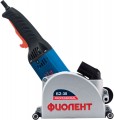Disc/cutter size
The diameter of the blade/cutter for which the tool is designed.
A larger blade can provide greater depth of cut, but requires a more powerful motor. Accordingly, this parameter is directly related to the power and performance of the tool: the more powerful and heavier the unit, the usually
larger the diameter of the working element in it. Note that some models allow the installation of cutters / discs and a smaller diameter than the standard one, but you cannot install a larger work item.
Processing width
The width of the furrow that the tool can cut. This parameter is relevant for models with a cutter (see "Work item") and units with several discs (see "Working discs / cutters"). In the first case, the processing width corresponds to the width of the cutter, in the second — to the distance between the discs. This distance can be changed by installing special washers on the spindle; therefore, in many tools, the processing width is indicated by a range, from minimum to maximum.
Processing depth
The depth to which the tool can cut through the material. This characteristic is directly related to the diameter of the blade / cutter (see above) — for
greater depth, a larger diameter is required. However, units with the same working element size may differ in the depth of processing due to the difference in engine power and some design features.
In many models, the depth can be adjusted; for such devices, the minimum and maximum depth values \u200b\u200bare indicated in the characteristics.

